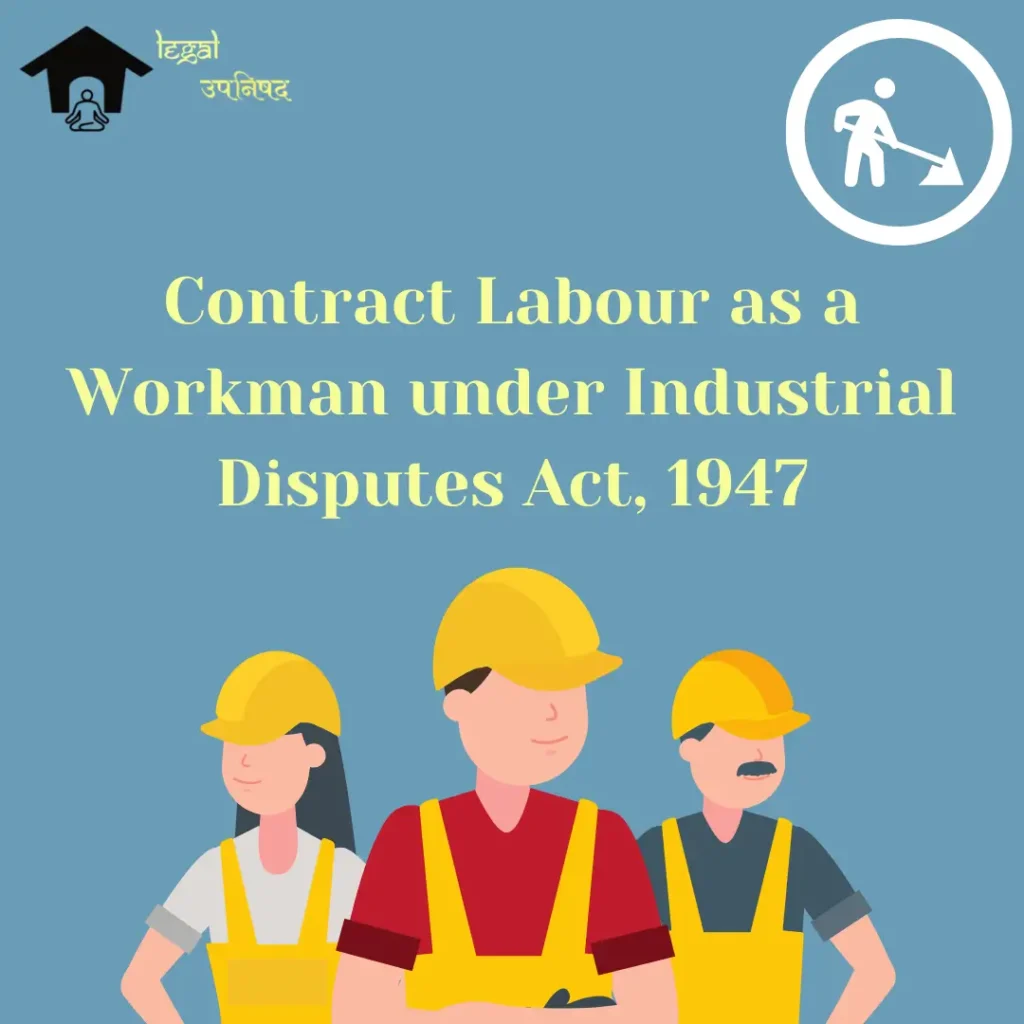This article on ‘Contract Labour as a Workman under Industrial Disputes Act, 1947‘ was written by Riya Chaudhary, an intern at Legal Upanishad.
Introduction
It is a point of unresolvable disagreement to resolve whether an employee qualifies as a workman or not. When an employee wants to use the Act’s protections in the event of a disagreement with his employer or when his employment is terminated, the employer objects, arguing that the person hired does not qualify as a workman under the act.
This article discusses Contract Labour as a Workman under the Disputes Act, 1947.
Workers under the Industrial Disputes Act, 1947
The Industrial Disputes Act, 1947 is the law that says what a worker’s vocation, industrial occupation, service, employment, or pastime is and what the employer’s business, trade, manufacture, or calling is. This law sets up the mechanisms and procedures for peacefully resolving disputes between an employer and an employee so that the workplace stays the same. Regardless of the number of employees, this Act will apply to all businesses and industries.
The term “industry” has developed, and today it even refers to organisations that are not operated for financial gain, including government initiatives, statutory organisations and businesses, associations, business chambers, educational institutions, co-ops, research institutes, nonprofit initiatives, and other comparable projects.
Section 2(s) defined Workman as:
Any person (including an apprentice) employed in any industry to do any manual, unskilled, skilled technical, operational, clerical, or supervisory work for hire or reward, whether the terms of employment be expressed or implied, and for the purpose of any proceeding under this Act in relation to an industrial dispute, includes any such person who has been dismissed, discharged or retrenched in connection with, or as a consequence of, that dispute, or whose dismissal, discharge or retrenchment has led to that dispute.


Contract Labour
It is crucial to talk about contract labour now because It represents a sizable and growing segment of the workforce. Independent contractors are increasingly used by large industrial organisations, who then provide workers to the company. A worker is not immediately made a member of the management when they are hired by a contractor to carry out the work for which he has a contract with a firm. Employees recruited by a contractor, for instance, to service the plant canteen, are not allowed to work for the company.
The contractor, not the management, is in charge of paying the workers’ compensation. However, contract employees are legally obligated to the contractor under Indian law; however, if the contractor fails to provide any benefits to which a contract labourer is legally entitled, The primary employer will be accountable. Their primary employer will be the company where they work. The law permits contractors to provide contract workers with benefits like provident funds and insurance.
Uncertainty surrounds whether contract labour will be regarded as a workman. In some cases, these labourers met the criteria for being considered workmen.
The emergence of a possible labour dispute involving contract, temporary, and casual workers may be caused by the following factors:
- A propensity or frequency of hiring workers who engage in activities that are prohibited by local notifications prohibiting the employment of contract labour;
- An excessively tight grip or restriction on the employee’s autonomy;
- A failure to comply with regulations requiring businesses to offer benefits to all of their employees, including a contract worker. The court had concluded that if the primary company maintains authority over contract workers. In Ram Singh & Others v. U.T. of Chandigarh, it was established that the contractor and the contract labourers were both directly employed by the principal employer.
Conclusion
For decades, courts and academics have debated the definition of “workmen” in various contexts. Given the conflicting legal interpretations of what constitutes a “workman” under the numerous laws, a single, universal definition of the term is urgently needed. Instead of the title, the type of responsibilities and authority granted to an employee is emphasised.
References:
- Kundan Singh Purohit, A “Workman” under the Industrial Disputes Act, 1947, HR vista, 30 November 2021, available at: https://hrvista.in/employee-relations/a-workman-under-the-industrial-disputes-act-1947#:~:text=The%20word%20’workman’%20means%20any,for%20hire%20or%20reward%20etc.
- Kanchak Modak, “Workman” Under Industrial Disputes Act, 1947, Mondaq, 14 October 2015, available at: https://www.mondaq.com/india/employee-rights-labour-relations/434328/workman-under-industrial-disputes-act-1947
- Shuchi, Which employees do not fall under the ambit of Industrial Dispute Act, 1947, Legal Services India, available at: www.legalservicesindia.com/article/422/Which-employees-do-not-fall-under-the-ambit-of-Industrial-Dispute-Act,-1947.html
- Definition of Workmen, B & B Associates, 8 November 2017, available at: https://bnblegal.com/article/definition-of-workman/
- Twinkle, Salient Features of The Industrial Disputes Act, 1947, Legal Services India, available at: https://www.legalserviceindia.com/legal/article-1031-salient-features-of-the-industrial-disputes-act-1947.html
